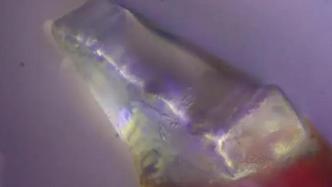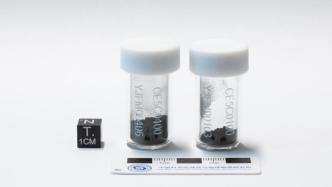
Recently, the news that Chinese scientists have discovered molecular water in lunar soil for the first time is exciting. Many netizens left messages in the news comment area to discuss "what vegetables should be planted on the moon". People in Shandong want to plant beans, people in Guizhou want to eat potatoes, and people in Jiangxi nominate peppers... The heated discussion forced the editor to reply: Don't plant them, you can't eat them all, you can't eat them all!
Can the lunar soil "water" be used to grow vegetables? Judging from this discovery, this is indeed possible.
Scientists discovered an unknown mineral crystal ULM-1 rich in water molecules and ammonium in the lunar samples brought back by Chang'e-5, revealing a possible form of water molecules on the moon - hydrated salt. The mineral formula contains up to six crystal waters, and the mass ratio of water molecules in the sample is as high as 41%. The water molecules in this hydrated salt can exist stably even in the sunlit areas on the moon, which is more conducive to resource development than volatile water ice.
Another feature that makes it suitable for growing vegetables is that this mineral has its own "fertilizer". This hydrated mineral is not only rich in water molecules, but also rich in ammonium (nitrogen fertilizer) and even a small amount of potassium (potassium fertilizer). This provides us with greater possibilities for growing crops on the moon in the future.
The significance of this discovery goes far beyond growing vegetables. The water on the moon is an important basis for humans to build long-term bases and develop resources on the moon. Water is the source of life. It is not only necessary to sustain life, but can also produce oxygen and hydrogen through electrolysis, providing gas security and fuel resources for human life and work on the moon. If a large number of such hydrated minerals can be found on the moon in the future, it will obviously provide more possibilities for human development of the moon.
Chang'e-5 is China's first unmanned lunar probe to return samples from the lunar surface. It successfully collected 1,731 grams of lunar soil samples at the end of 2020. A large number of scientific research results have been produced around these samples, and more than 100 high-quality papers have been published. The discovery of molecular water in the lunar soil is one of them. Chang'e-6, which returned a month ago, obtained the first sample from the far side of the moon, 1,935.3 grams. The fruitful results of Chang'e-5's lunar sample research make us more excited about Chang'e-6's lunar far side samples. Like Chang'e-5, finding water resources is also one of the important topics of Chang'e-6's lunar far side sample research.
Is there water on the moon? Can lunar water be used for human space activities? The answer to this question is related to the development prospects of human spaceflight. The first discovery of molecular water in lunar soil is undoubtedly a huge opportunity for commercial spaceflight. On the one hand, this discovery will enhance the feasibility of existing lunar exploration and development projects and attract more funds and resources to the space industry; on the other hand, this discovery indicates the possibility of reducing the cost of lunar construction and development, narrowing the distance from space exploration to commercial projects.
The discovery of molecular water in lunar soil is also a boon to the Chinese people's dream of the stars and the sea. China's manned lunar exploration mission has been launched, and it is planned to realize the first Chinese landing on the moon before 2030. The International Lunar Research Station, jointly built by China and many other countries, plans to complete the basic model by 2035, with the South Pole of the Moon as the core, to build a comprehensive scientific facility with basically complete functions and basic supporting elements, to carry out regular scientific experimental activities and a certain scale of resource development and utilization; to complete the expansion model by 2045, with the lunar orbital station as the hub, to build equipment and facilities with complete functions, considerable scale and stable operation, to carry out comprehensive lunar-based scientific research and in-depth resource development and utilization.
Of course, opportunities always come with challenges, and great opportunities are often accompanied by great challenges. We are facing unknown challenges: For the estimation of lunar water resources, various international studies have given different data, which are far from each other. The question of how much water resources there are on the moon still requires more lunar exploration and related research to clear the fog and outline a blueprint. We are facing the challenge of development: before developing lunar water resources, we must evaluate the potential impact of water resource exploitation on the lunar environment, and adopt the best solution that takes into account both environmental protection and economic benefits during development to ensure the long-term sustainable development of the lunar base.
The moon is the closest celestial body to the earth and the first stop for mankind to enter the universe. Looking forward to the future lunar base, the food and vegetables grown there will surely herald the arrival of a prosperous aerospace era.
